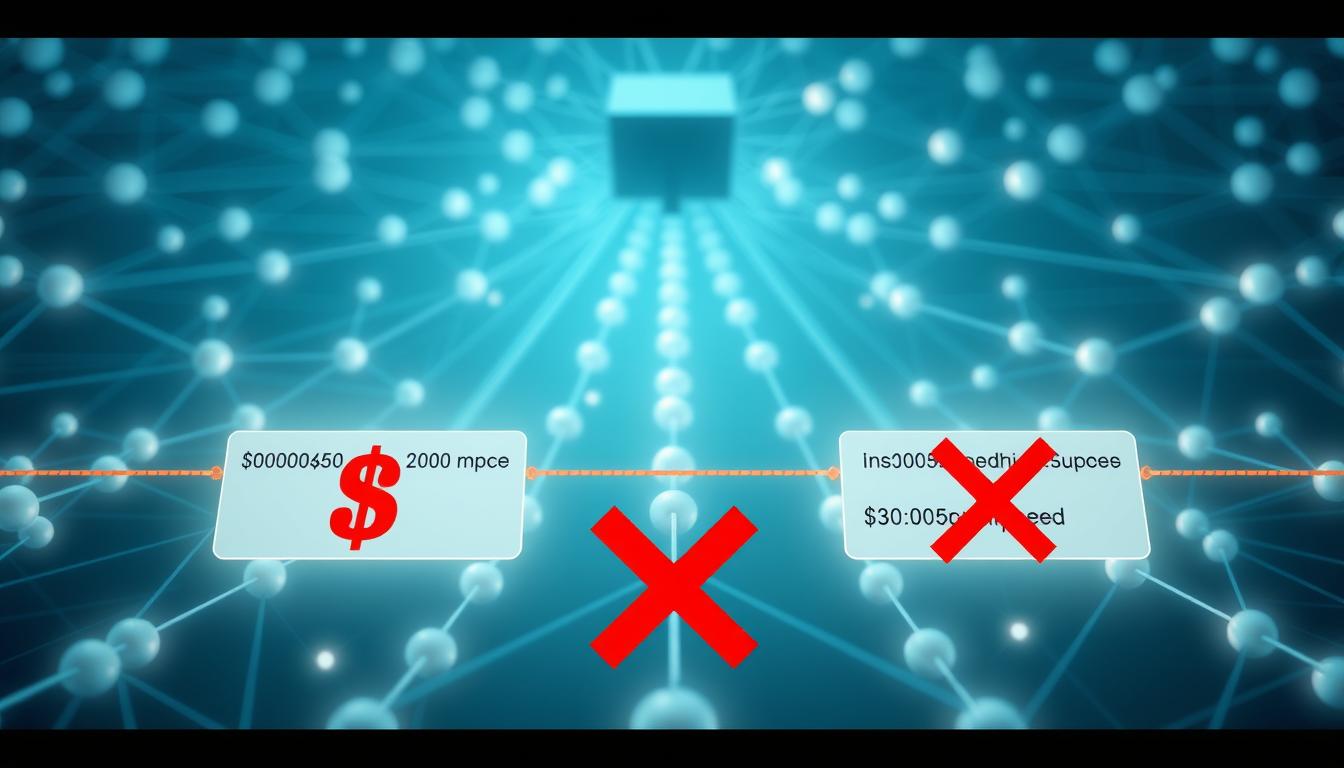Now Reading: How Does Blockchain Prevent Double Spending Explained
- 01
How Does Blockchain Prevent Double Spending Explained
How Does Blockchain Prevent Double Spending Explained

Digital currency faced a critical challenge before the emergence of blockchain technology. The double spending problem threatened the entire concept of electronic cash. This issue occurs when someone tries to spend the same digital currency multiple times.
Traditional financial systems rely on central authorities like banks to verify transactions. Blockchain offers a revolutionary approach using decentralized verification. The technology creates an immutable ledger that records every transaction permanently.
According to Bitcoin’s original whitepaper, the solution involves a peer-to-peer distributed timestamp server. This system generates computational proof of transaction chronology. As of June 2024, Bitcoin’s network demonstrates impressive security with over 19,500 nodes and a hashrate of 670 exa hashes per second.
The security of this approach depends on honest nodes controlling more computational power than potential attackers. This distributed verification process makes fraudulent transactions practically impossible. The system maintains integrity through cryptographic techniques and economic incentives.
Key Takeaways
- Blockchain technology solves the fundamental double spending problem that plagued earlier digital currency attempts
- The system uses decentralized verification instead of relying on central authorities
- Every transaction receives a cryptographic timestamp that establishes chronological order
- Network security depends on honest participants controlling majority computational power
- The distributed ledger creates permanent, immutable records of all transactions
- Multiple security layers work together to prevent fraudulent spending attempts
- Real-world implementations like Bitcoin demonstrate the effectiveness of this approach
Introduction to Blockchain and Double Spending
A persistent flaw in digital cash systems required an innovative technological solution. This vulnerability threatened the very foundation of electronic money.
Overview of Blockchain Technology
Blockchain represents a distributed ledger system that records transactions across multiple computers. Unlike traditional databases, this approach eliminates single points of failure.
The technology organizes data into chronological blocks linked through cryptographic hashing. Each block contains a timestamp and reference to the previous block. This creates an immutable chain of records.
Why Double Spending is a Critical Issue
The Byzantine Generals’ Problem illustrates the challenge of achieving consensus without central authority. Malicious participants could attempt to spend the same digital currency twice.
Real-world attacks demonstrate this threat’s seriousness. Ethereum Classic experienced a $1.6 million theft through duplicate spending. Such incidents highlight the need for robust security measures.
| System Feature | Traditional Centralized | Blockchain Distributed |
|---|---|---|
| Verification Method | Third-party intermediaries | Network consensus |
| Transaction Security | Central authority dependent | Cryptographic proof-based |
| Data Transparency | Limited access | Public ledger visibility |
| System Resilience | Single point failure risk | Distributed redundancy |
The integrity of electronic money depends on preventing duplicate transactions. Blockchain’s architecture provides the necessary safeguards against this fundamental problem.
How Does Blockchain Prevent Double Spending
Decentralized verification systems create an environment where duplicate spending becomes computationally impractical. This approach relies on network-wide participation rather than centralized control.
The Role of Distributed Ledgers
Every participant in the network maintains an identical copy of the complete transaction history. This shared ledger architecture ensures transparency across all nodes.
When someone initiates a payment, the details broadcast to the entire network. Each node independently checks the existing records to confirm fund availability.
Verification Through Consensus Mechanisms
Network participants collectively validate transactions before permanent recording. Systems like Proof of Work require computational effort to establish trust.
Conflicting entries where the same funds appear twice get rejected automatically. This multi-layered security makes fraudulent activities extremely difficult.
| Security Feature | Distributed Ledger | Traditional System |
|---|---|---|
| Record Storage | Multiple identical copies | Centralized database |
| Verification Process | Network consensus | Third-party approval |
| Update Authority | Majority agreement | Single administrator |
| Failure Resistance | High redundancy | Single point risk |
The combination of distributed record-keeping and collective validation establishes strong protection. This system maintains integrity through mathematical proofs and economic incentives.
Understanding the Double Spending Problem
The core vulnerability that plagued early digital payment systems was the ability to duplicate transactions. This fundamental issue made electronic money unreliable without proper safeguards.
Defining Double Spending in Digital Currency
Double spending occurs when the same digital funds get used for multiple payments. Unlike physical cash that changes hands visibly, electronic currency exists as data that can be copied.
Services sometimes accept transactions before blockchain confirmation. This creates windows where the same cryptocurrency could be spent elsewhere. Flawed smart contracts also enable this problem through weak validation checks.

A simple example shows how this works. If Jane receives payment from both Alice and Bob for the same debt, she effectively spends the obligation twice. The system fails to recognize the duplication.
Historical Challenges and Context
Early digital currency attempts consistently failed due to this vulnerability. Without centralized verification, there was no way to ensure funds weren’t already spent.
Previous electronic cash systems relied on trusted third parties. Blockchain’s distributed approach finally solved this decades-old problem through network consensus.
| Aspect | Physical Currency | Digital Currency (Pre-Blockchain) |
|---|---|---|
| Duplication Risk | Physically impossible | High vulnerability |
| Verification Method | Visual confirmation | Central authority dependent |
| Transaction Speed | Slower, physical transfer | Instant but risky |
| Security Foundation | Tangible possession | Database records |
Understanding these historical struggles highlights why blockchain’s solution was revolutionary. The technology addressed a critical flaw that prevented decentralized digital money from succeeding.
Technical Mechanisms Behind Double Spending Prevention
Blockchain’s defense against fraudulent transactions relies on three interconnected technical components. These mechanisms work together to create an unforgeable record of financial activity.
Timestamping and Its Importance
Each block contains a precise timestamp marking its creation time. This establishes the chronological order of all transactions.
When a block is added to the chain, the timestamp becomes permanent. This prevents anyone from claiming funds were available elsewhere.

Nonce and Proof-of-Work Explained
Miners search for a special value called a nonce. This work involves generating countless hash attempts.
The proof-of-work mechanism requires significant computational effort. This makes fraudulent blocks economically impractical to create.
Role of Cryptographic Hashing
Cryptographic hashing creates unique digital fingerprints for each block. Even tiny changes to transaction data produce completely different results.
This ensures immediate detection of any tampering attempts. The network automatically rejects altered blocks, maintaining system integrity.
Consensus Mechanisms in Blockchain Security
Network-wide agreement protocols form the backbone of blockchain’s security architecture against financial fraud. These consensus mechanisms enable all participants to validate transactions collectively without central authority.

Proof of Work versus Proof of Stake
Proof of Work requires miners to solve complex puzzles using computational power. This energy-intensive process makes fraudulent activities economically impractical.
Proof of Stake selects validators based on their financial stake in the network. Validators risk losing their collateral if they approve invalid transactions, creating strong economic incentives for honesty.
Delegated Systems and Their Impact
Delegated Proof of Stake introduces a representative model where stakeholders vote for validators. This approach maintains security while improving transaction speed and efficiency.
All these consensus mechanisms serve the same fundamental purpose: making duplicate financial activities impossible through economic or computational barriers. Understanding these consensus protocols reveals why blockchain networks remain secure against manipulation attempts.
Role of Network Nodes and Miner Incentives
Miner incentives and node participation create a self-reinforcing security model that grows stronger with network expansion. Each participant contributes computing power, making the system more resilient against attacks.
Network Propagation and Block Confirmation
Network propagation ensures all nodes receive transaction data quickly. This rapid sharing helps detect conflicting entries that might indicate duplicate spending attempts.
When a block is added to the chain, confirmation begins. Each subsequent block makes previous transactions more secure. Multiple confirmations provide strong protection against reversal.

Node Operation and Miner Rewards
Nodes independently verify every transaction, maintaining complete blockchain copies. This redundancy prevents any single entity from manipulating records.
Miners receive rewards for successfully adding blocks. This economic incentive attracts honest participants and strengthens network security. The system aligns financial interests with proper operation.
| Security Aspect | Large Network (19,500+ nodes) | Small Network |
|---|---|---|
| Attack Resistance | Extremely high | Moderate |
| Propagation Speed | Very fast | Slower |
| Confirmation Reliability | Highly secure | Less secure |
| Economic Attack Cost | Prohibitively expensive | More feasible |
The combination of distributed validation and financial rewards creates robust protection. This approach makes fraudulent activities economically impractical for attackers.
Real-Life Double Spending Attacks and Examples
Historical incidents provide concrete evidence of double spending attacks that have successfully exploited vulnerabilities. These real-world cases demonstrate the importance of robust security measures in cryptocurrency systems.
The Ethereum Classic incident stands as a stark reminder. An attacker stole over $1.6 million by spending the same tokens multiple times. This remains one of history’s record-breaking double spending attacks.
Case Study: Bitcoin’s Proven System
Bitcoin’s network has never experienced a successful double spending attack since its creation. This remarkable track record validates the effectiveness of its security architecture.
The system’s resilience comes from its massive decentralized network. With thousands of nodes participating in verification, fraudulent activities become practically impossible.
Examples of Finney and Race Attacks
Several sophisticated attack methods have emerged over time:
- Finney Attack: An attacker pre-mines a block containing a transaction but delays broadcasting it. They then make a purchase from a vendor using the same funds. When the vendor releases goods, the attacker broadcasts their pre-mined block, invalidating the payment.
- Race Attack: This method exploits merchants who accept zero-confirmation transactions. The attacker sends two conflicting transactions simultaneously. The network confirms whichever transaction validators see first, causing the legitimate payment to fail.
- 51% Attack: The most severe form requires controlling majority network power. The attacker can reorganize the blockchain, reverse confirmed transactions, and execute double-spend operations.
These examples show varying levels of sophistication in double spending attacks. They highlight why proper transaction confirmations remain essential for security.
Strategies to Mitigate Double Spending Risks
Practical security measures form essential safeguards against digital currency vulnerabilities. These approaches combine technical protocols with economic incentives to create robust protection.
Transaction confirmation policies serve as the primary defense layer. The standard practice involves waiting for six block confirmations before considering payments final.
Transaction Confirmations and Security Policies
Six confirmations typically complete within 3 to 30 minutes. This timeframe balances security needs with practical transaction speed.
Each additional block makes reversal increasingly difficult. The computational effort required becomes economically impractical for attackers.
Merchants should implement confirmation requirements based on transaction value. High-value payments need more confirmations than small purchases.
Layer 2 Solutions and Off-Chain Transactions
Secondary protocols like the Lightning Network enable faster payments. These systems conduct transactions off the main ledger while maintaining security.
Payment channels create cryptographically secured pathways between participants. Final balances settle on the primary chain when channels close.
This approach significantly reduces crypto transaction fees while maintaining protection. Off-chain solutions provide efficiency without compromising safety.
Key mitigation strategies include:
- Confirmation requirements: Waiting for multiple block validations
- Economic barriers: High staking requirements for node operators
- Real-time monitoring: Detecting conflicting transaction attempts
- Layer 2 adoption: Using off-chain protocols for appropriate transactions
These combined approaches create multi-layered security that makes fraudulent activities increasingly difficult and economically irrational.
Future Innovations in Double Spending Prevention
Next-generation validation systems are transforming how digital transactions achieve trust and finality. These advancements build upon existing security foundations while introducing novel approaches.
Emerging technologies promise more efficient and robust protection mechanisms. The focus shifts toward proactive security measures.
Emerging Consensus Models
New validation methods like Proof of Space and Time utilize storage capacity instead of pure computing power. This approach reduces energy consumption while maintaining strong security.
Hybrid consensus mechanisms combine multiple validation techniques for enhanced protection. These systems leverage the strengths of different approaches.
Technological Advancements and Predictive Analysis
Machine learning algorithms analyze historical transaction data to identify potential threats. This predictive capability allows networks to anticipate and block fraudulent attempts.
Sharding technology divides the ledger into smaller segments for parallel processing. This increases transaction speed while reducing vulnerability windows.
Integrating Smart Contract Audits
Comprehensive code reviews have become essential for preventing exploitation through flawed logic. Professional audits identify vulnerabilities before deployment.
Zero-Knowledge Proofs enable verification without revealing sensitive transaction details. This maintains privacy while ensuring security against duplicate activities.
Key innovations shaping future protection include:
- Advanced consensus mechanisms that use alternative resources for validation
- Predictive security systems that anticipate threats before execution
- Enhanced privacy protocols that verify transactions confidentially
- Automated audit processes that continuously monitor for vulnerabilities
Conclusion
Digital trust achieved through cryptographic verification has transformed how we approach electronic currency security. The solution to duplicate transaction issues stands as blockchain’s most significant contribution to finance.
From Bitcoin’s original timestamp method to modern hybrid consensus models, the techniques continue evolving. This knowledge remains essential for all cryptocurrency participants to ensure proper security practices.
The multi-layered approach combining technical mechanisms, network effects, and economic incentives creates robust protection. While established networks demonstrate effectiveness, implementation details and network size remain critical factors.
Future innovations promise even more efficient and scalable security solutions. These advancements will maintain the fundamental properties that make digital currency systems valuable and trustworthy.
FAQ
What is the fundamental method a blockchain uses to secure transactions?
The system relies on a distributed ledger and a network of computers, called nodes, that must agree on the order of transactions. This agreement, achieved through consensus mechanisms like Proof of Work, ensures that once a payment is recorded, altering it is practically impossible.
Why can’t traditional digital money easily solve the double-spending problem?
Before systems like Bitcoin, digital assets were just data. A central authority, like a bank, was needed to verify that the same funds weren’t spent twice. Without this trusted third party, it was difficult to prevent someone from copying and reusing the same digital currency.
How does the Proof-of-Work mechanism contribute to security?
Proof of Work requires miners to solve complex mathematical puzzles. This process consumes significant computing power and time, making it extremely difficult for an attacker to rewrite the transaction history. The longest valid chain, which represents the most computational effort, is accepted as truth by the network.
What is a Finney attack and how is it mitigated?
A Finney attack is a specific type of double-spending attempt where a miner pre-mines a block containing a transaction but doesn’t broadcast it immediately. They then spend the same coins in a second transaction. This risk is reduced by waiting for multiple block confirmations, as the pre-mined block would likely be orphaned by the network’s longer chain.
Are some consensus mechanisms more secure against attacks than others?
Yes, different models offer varying levels of protection. Proof of Work secures the network through energy expenditure, making attacks costly. Proof of Stake secures it by requiring participants to lock up a valuable amount of cryptocurrency, making malicious actions financially punitive. Each has its own strengths against different threats.
How many confirmations are typically needed to consider a transaction safe?
The number of confirmations needed depends on the value of the transaction and the specific blockchain. For smaller amounts on a robust network like Bitcoin, one confirmation may suffice. For larger sums, merchants often wait for six or more blocks to be added to the chain, drastically reducing the risk of a successful double spend.
What role do network nodes play in preventing this issue?
Nodes are critical. They independently validate every transaction and block according to the network’s rules. They reject any invalid data, such as an attempt to spend the same funds twice. This decentralized verification by many participants ensures no single entity can control or corrupt the ledger.















